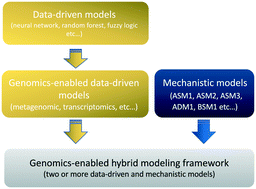Emerging investigator series: modeling of wastewater treatment bioprocesses: current development and future opportunities
Abstract
For more than a half-century, modelers have developed various modeling strategies to facilitate the transition of wastewater treatment bioprocesses from lab-scale demonstration to full-scale applications. This review presents the mathematical fundamentals of mechanistic models, machine learning algorithms of data-driven models, and hybrid modeling strategies for different biological wastewater treatment systems including activated sludge processes, anaerobic digesters, anammox processes, and bioelectrochemical systems. The discussion is focused on the biological principles in those modeling strategies. The conventional Monod expressions are a prevailing tool to describe the mathematical connection between microbial kinetics and state variables in mechanistic models. Stoichiometric equations and steady-state conditions are also required for the mechanistic modeling approach to predict system performance such as the removal of carbon, nitrogen, and phosphorus. On the other hand, data-driven models statistically link the inputs and outputs for the prediction and optimization of system performance with a minimum requirement of a priori knowledge. Although this strategy shows outstanding learning ability of data interpolation, the predictions are often uninterpretable due to the black-box nature. Hybrid modeling strategies have the potential to address the inherent limitations of standalone models. Currently, the mechanistic and data-driven components in hybrid models are still structured based on microbial kinetics and trained with physical and biochemical data, respectively. This problem can be potentially solved by incorporating genomics data into model construction to link microbial kinetic to microbial population and functional dynamics. We discuss the perspectives of incorporating genomic data into model construction and propose genomics-enabled hybrid modeling strategies for future research.

- This article is part of the themed collection: Emerging Investigator Series


 Please wait while we load your content...
Please wait while we load your content...